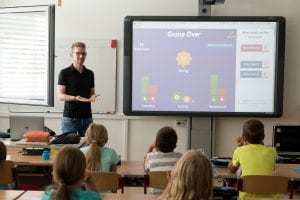
Credit: Steveriot1
It’s me, isn’t it.
No but seriously, digital citizenship must be embedded in our teaching, not just because it is one of the General Capabilities (ACARA, 2023).
In my role as a TL (though not yet qualified to call myself one!), I teach sessions on academic integrity
(which includes research and referencing) for other classes – today I did one with a Sport Science class; last week I taught an Accounting class. Part of my lesson is to stress the ‘integrity’ part, which is I believe key to being a digital citizen. Not plagiarising is part self-protection, part digital literacy and communication, and part self-respect and respect for others. My school is taking this even more seriously due to the increase in students who are submitting assignments that are completely or partly written by ChatGPT.
As more teachers are starting to take it seriously, so too I hope they consider integrating digital literacy and digital citizenship into their classes, throughout the year. Krueger (2022) states that digital citizenship needs to be integrated across all subject areas, all year, in order to be effective. Her suggestion regarding research projects, of teaching students how to curate sources, would work well in the senior secondary context I work in – the challenge is finding the time in a tightly-packed curriculum to do this.
Which brings me to the Smithsonian Museum’s Learning Lab, which has designed resources for teaching students to curate sources, respect copyright and correctly reference – I will park this link to Darren Milligan’s article here so I can find it again later!
In the video interview with Dr Mike Ribble (Learning Technology Center, 2023), he talked about a teacher who got her students to put the assignment into ChatGPT and then work out where its responses were lacking or wrong, and redo it. That’s an excellent way to develop strong literacy skills while also teaching them not to trust everything they read online. As Dr Ribble says, ChatGPT can make things up, including references. That I didn’t know; I had however heard that it can’t really tell the difference between information and misinformation. So part of my job is to teach students how to assess sources of information – all part of digital citizenship.
I am currently reading Man-Made: How the bias of the past is being built into the future by Tracey Spicer which adds another layer to Ribble’s point that you can’t actually trust AI. I might have had some suspicions, but I didn’t know. I didn’t realise the extent of the problem: that when technologies are designed and programmed by a select few, who are all mostly the same (Spicer identifies them as primarily white and Asian men, usually young), all sorts of gender and race biases are built into the technology. She mentions one early experiment, an AI ‘bot’ released on Twitter called ‘Tay’, that – through machine learning (otherwise known as artificial intelligence) – became an anti-feminist neo-Nazi in just 24 hours. That is, it learned this from other Twitter uses. You can read more about it here.
The other part of the video that I felt myself nodding along to, is the role of parents – the vast majority of parents in Australia give their young children mobile devices to play on and watch videos on, from a very young age. It’s become ‘normal’, it’s normalised, and as a parent I totally understand the motivation for it. But I think parents forget that they’ve just added another layer of teaching to their role, one they themselves might not be so knowledgeable in (we use devices all the time but that doesn’t mean we’re good digital citizens). I don’t know what the answer is there, but if we can teach out students to be digital citizens, throughout their schooling, then hopefully when they become parents themselves they’ll be able to impart some of that wisdom before their children even start school.
All of this aligns with Bombardelli’s (2021) point about life-long learning, active citizenship and discrimination – that our (very human) prejudices are being built into our technology (which we are encouraged to think of as ‘neutral’), and that this needs to be taken into consideration when promoting active online participation, as discussed by Bombardelli. It’s basically an extension of the idea that we can’t believe everything we read online. There are so many benefits, but if we (schools) aren’t teaching people from a young age not only how to be a responsible online citizen, but also teach them the tools they need to navigate this vast and tumultuous space, the problems of the present will only continue – and worsen.
References
ACARA. (2023). Digital Literacy. Australian Curriculum, v9. https://v9.australiancurriculum.edu.au/teacher-resources/understand-this-general-capability/digital-literacy
Bombardelli, O. (2021). Digital Citizenship and Life Long Learning. In: Auer, M., May, D. (eds) Cross Reality and Data Science in Engineering. REV 2020. Advances in Intelligent Systems and Computing, vol 1231. Springer, Cham. https://doi-org/10.1007/978-3-030-52575-0_67
Learning Technology Center. (2023, November 28). A.I. and Digital Citizenship with Dr. Mike Ribble [Video]. YouTube. https://www.youtube.com/watch?v=gzTEwQr8T88
. (n.d.). Welcome to the Smithsonian’s Learning Lab. Smithsonian Learning Lab. https://learninglab.si.edu/
Spicer, T. (2023). Man-Made: How the bias of the past is being built into the future. Simon & Schuster.

















Leave a Reply